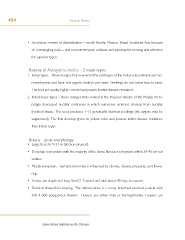Page 454 - FRUTAS DEL TRÓPICO
P. 454
454 Frutas del trópico
• Secondary centers of diversification —south Florida, Mexico, Brazil, Southeast Asia because
of commingling poly— and monoembryonic cultivars and subsequent crossing and selection
for superior types.
Botany of Mangifera indica – 2 main types
1. Indian types – those mangos that evolved in the subtropics of the Indian subcontinent are mo-
noembryonic and have one zygotic embryo per seed. Seedlings do not come true to seed.
The fruit are usually highly colored and posses limited disease resistance.
2. Indochinese types – those mangos that evolved in the tropical climates of the Maylay Archi-
pelago developed nucellar embryony in which numerous embryos develop from nucellar
(mother) tissue. The seed produces 1-13 genetically identical seedlings (the zygote may be
suppressed). The fruit develop green to yellow color and possess better disease resistance
than Indian types.
Botany – gross morphology
• Large trees to 9-31 m tall (non-pruned).
• Deep tap root system with the majority of the dense fibrous root system within 30-45 cm soil
surface.
• Mostly evergreen – leaf abscission rate is influenced by climate, disease pressures, and flowe-
ring.
• Leaves are simple and long-lived (2-5 years) and take about 40 days to mature.
• Terminal flower/fruit bearing. The inflorescence is a many branched terminal panicle with
300-4 000 polygamous flowers. Flowers are either male or hermaphrodite. Flowers are
Universidad Autónoma de Chiapas

